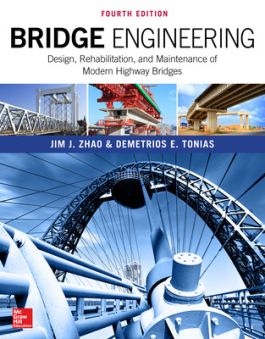Bridge Engineering: Design, Rehabilitation, and Maintenance of Modern Highway Bridges, Fourth Edition
Step 1. Download Adobe Digital Editions Both PC and Mac users will need to download Adobe Digital Editions to access their eBook. You can download Adobe Digital Editions at Adobe's website here.
Step 2. Register an Adobe ID if you do not already have one. (This step is optional, but allows you to open the file on multiple devices) Visit account.Adobe.com to register your Adobe account.
Step 3: Authorize Adobe Digital Editions using your Adobe ID. In Adobe Digital Editions, go to the Help menu. Choose “Authorize Computer.”
Step 4: Open your file with Adobe Digital Editions. Once you’ve linked your Adobe Digital Editions with your Adobe ID, you should be able to access your eBook on any device which supports Adobe Digital Editions and is authorized with your ID. If your eBook does not open in Adobe Digital Editions upon download, please contact customer service
1.1 USE AND FUNCTIONALITY
1.1.1 Terminology and Nomenclature
1. Superstructure
2. Substructure
3. Appurtenances and Site-Related Features
4. Miscellaneous Terms
1.1.2 Structure Types and Applications
1. Slab-on-Girder
2. One-Way Slab
3. Steel and Concrete Box Girder
4. Cable-Stayed
5. Suspension
6. Steel and Concrete Arch
7. Truss
1.2 ORIGINS OF THE MODERN HIGHWAY BRIDGE
1.3 BRIDGE DESIGNERS AND THEIR PROJECTS
1.4 THE BRIDGE ENGINEERING LEXICON
REFERENCES
Section 2 Project Inception
2.1 PROJECT FUNDING
2.1.1 User Fees
2.1.2 Nonuser Fees
2.1.3 Special Benefit Fees
2.1.4 Private Financing
2.1.5 Debt Financing
2.1.6 Conclusions
2.2 TYPES OF DESIGN STANDARDS
2.2.1 General Specifications
2.2.2 Material-Related Design Codes
1. Steel
2. Concrete
3. Timber
2.2.3 Use of Design Standards
2.3 SITE INSPECTION
2.3.1 The Qualifications of Inspectors
2.3.2 The Design Inspection
2.3.3 Recording the Inspection
2.3.4 Rating Substructure Elements
1. Joints
2. Bearings, Bridge Seats, and Pedestals
3. Concrete Elements
4. Steel Elements
5. Timber Elements
6. Embankment
2.3.5 Rating Superstructure Elements
1. Deck and Wearing Surface
2. Primary and Secondary Members
2.3.6 Rating Appurtenance and Site-Related Elements
1. Railing
2. Drainage Systems
3. Utilities
4. Lighting and Signing
2.3.7 Inspecting for Scour
1. The Channel
2. The Substructure
2.3.8 Conclusions
2.4 SITE SURVEY
2.4.1 Topography
2.4.2 Planimetry
2.4.3 Structure Features
2.5 PHYSICAL TESTING
2.5.1 Coring
2.5.2 Delamination Testing
2.5.3 Testing for Cover
2.5.4 Measuring Steel Thickness
2.5.5 Detecting Fatigue Cracks
2.6 THE INSPECTION TEAM
2.7 AS-BUILT PLANS AND OTHER RECORD DATA
2.7.1 Supplementing As-Built Plans
1. Guard Railing
2. Drainage Facilities
3. Traffic Barriers
4. Miscellaneous Elements
2.7.2 Other Sources
2.8 CONCLUSIONS
REFERENCES
Section 3 The Superstructure
3.1 SUPERSTRUCTURE TYPES
3.1.1 Steel Superstructures
1. Rolled Beam
2. Rolled Beam with Cover Plate
3. Plate Girder
4. Box Girder
5. Steel Rigid Strut Frame
6. Large Structures
3.1.2 Concrete Superstructures
1. Prestressed Concrete Girder
2. Concrete Box Girder
3. Concrete Slab
4. Adjacent Prestressed Slab
5. Concrete Rigid Frame
6. Concrete Strut Frame
7. Concrete Arch
3.1.3 Timber Superstructures
1. Glulam Timber
2. Stress-Laminated Timber Deck
3. Trestle
4. Truss
3.1.4 Secondary Members
1. Diaphragms
2. Lateral Bracing
3. Portal and Sway Bracing
3.2 DECK TYPES
3.2.1 Noncomposite and Composite Decks
3.2.2 Cast-in-Place Concrete Slab
3.2.3 Full-Depth Precast Concrete Panels
3.2.4 Partial-Depth Precast Concrete Panels
3.2.5 Steel Orthotropic Plate
3.2.6 Steel Grid
3.2.7 Timber
3.2.8 Corrugated Metal
3.2.9 Fiber Reinforced Polymer (FRP)
3.3 WEARING SURFACE TYPES
3.3.1 Asphalt Concrete
3.3.2 Polymer Modified Concrete
3.3.3 Micro-Silica Concrete
3.3.4 High-Performance Concrete
3.3.5 Integrated Wearing Surface
3.4 DECK JOINT TYPES
3.4.1 Open and Sealed Joints
3.4.2 Poured Joints
3.4.3 Compression Seal Joints
3.4.4 Strip Seal Joints
3.4.5 Modular Joints
3.4.6 Finger Plate Joints
3.4.7 Sliding Plate Joints
3.4.8 Conclusions
3.5 DESIGN LOADS
3.5.1 Background and History
3.5.2 Permanent Loads
1. Dead Load
2. Superimposed Dead Load
3. Pressures
4. Superimposed Deformations
3.5.3 Transient Loads
1. Vehicular Live Load
2. Pedestrian Load
3. Earthquake Loading
4. Wind Loading
5. Channel Forces
6. Braking Force
7. Centrifugal Forces
8. Dyna
Bridge engineering essentials—fully updated to reflect the latest standards and regulations
This thoroughly revised resource combines the latest LRFD bridge engineering standards with cutting-edge maintenance and rehabilitation techniques, enabling you to successfully address today’s challenging infrastructure projects. The book features cutting-edge analysis, design, and construction practices along with proven, cost-effective maintenance and repair methods.
Bridge Engineering: Design, Rehabilitation, and Maintenance of Modern Highway Bridges, Fourth Edition, examines the entire lifecycle of a bridge, from inception, design, and construction to long-term maintenance and management. Two brand-new chapters cover foundations and superstructure rehabilitation. Real-world case studies and hundreds of helpful photos and illustrations are also included.
• Fully aligns with the 7th Edition of AASHTO’s LRFD Bridge Design Specifications
• All examples and equations are presented in both S.I. and U.S. units
• Written by a pair of experienced civil engineers

